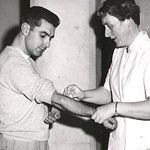Prevention
Over the years many efforts have been made to stop the spread of tuberculosis. From legislation banning spitting in public, to the development of vaccinations, to public screening programs, preventative efforts have sought to inform people about the disease and to stop the spread of the disease.
robert koch - tuberculin
At the 10th International Congress of Medicine in Berlin in 1890, Robert Koch announced that he had found a substance that would protect against tuberculosis – tuberculin. The medical community reacted with mixed results. Koch’s renown for his discovery of the tuberculosis bacteria in 1882 gave him credence with many, yet many others reserved judgement because Koch refused to identify the material used in tuberculin until 1891. It was then revealed that tuberculin is an attenuated mixture of dead bacteria, as well as of proteins and antigens found in the fluid in which Mycobacterium tuberculosis had been grown. Tuberculin was administered through a subcutaneous injection. Many recipients of the vaccine had strong negative reactions, however, and the medical community quickly came to see the benefits of tuberculin not as a vaccine, but as diagnostic test.
The tuberculin skin test involves injecting a small amount of tuberculin under the skin and observing whether there is immune response, such as swelling and blistering, which indicates that the body has been in contact with the substance before, that the individual has been infected with tuberculosis (see Diagnosis - Skin Test).
In Canada, by the 1920s tuberculin skin tests were being used as part of mass screenings of communities to test for tuberculosis. In 1921 the Saskatchewan Anti-Tuberculosis Commission tested 1700 school children, revealing that 44% had been infected with tuberculosis by age 6, that 60% were infected by age 14, and that 76% were infected by age 18, but that only 0.84% had active tuberculosis. Additional tests, such as x-ray screenings, were also used to further identify active cases.
Tuberculin skin tests continue to be the most commonly used diagnostic tool for tuberculosis.
Explore the picture gallery to learn more about this preventative measure.


